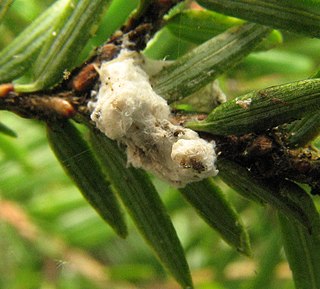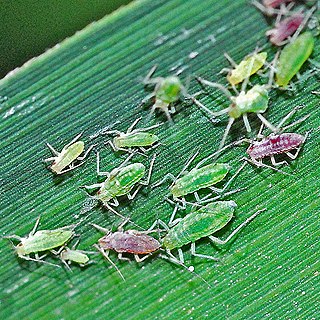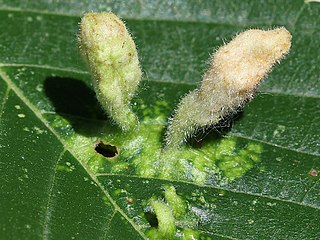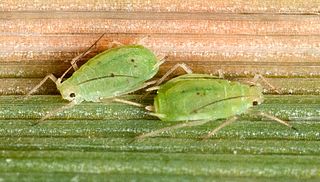
Aphids are small sap-sucking insects and members of the superfamily Aphidoidea. Common names include greenfly and blackfly, although individuals within a species can vary widely in color. The group includes the fluffy white woolly aphids. A typical life cycle involves flightless females giving live birth to female nymphs—who may also be already pregnant, an adaptation scientists call telescoping generations—without the involvement of males. Maturing rapidly, females breed profusely so that the number of these insects multiplies quickly. Winged females may develop later in the season, allowing the insects to colonize new plants. In temperate regions, a phase of sexual reproduction occurs in the autumn, with the insects often overwintering as eggs.

Hemiptera is an order of insects, commonly called true bugs, comprising over 80,000 species within groups such as the cicadas, aphids, planthoppers, leafhoppers, assassin bugs, bed bugs, and shield bugs. They range in size from 1 mm (0.04 in) to around 15 cm (6 in), and share a common arrangement of piercing-sucking mouthparts. The name "true bugs" is often limited to the suborder Heteroptera.

The Aphididae are a very large insect family in the aphid superfamily (Aphidoidea), of the order Hemiptera. These insects suck the sap from plant leaves. Several thousand species are placed in this family, many of which are considered plant/crop pests. They are the family of insects containing most plant virus vectors with the green peach aphid being one of the most prevalent and indiscriminate carriers.

A leafhopper is the common name for any species from the family Cicadellidae. These minute insects, colloquially known as hoppers, are plant feeders that suck plant sap from grass, shrubs, or trees. Their hind legs are modified for jumping, and are covered with hairs that facilitate the spreading of a secretion over their bodies that acts as a water repellent and carrier of pheromones. They undergo a partial metamorphosis, and have various host associations, varying from very generalized to very specific. Some species have a cosmopolitan distribution, or occur throughout the temperate and tropical regions. Some are pests or vectors of plant viruses and phytoplasmas. The family is distributed all over the world, and constitutes the second-largest hemipteran family, with at least 20,000 described species.

The Sternorrhyncha suborder of the Hemiptera contains the aphids, whiteflies, and scale insects, groups which were traditionally included in the now-obsolete order "Homoptera". "Sternorrhyncha" refers to the rearward position of the mouthparts relative to the head.

The witch-hazel cone gall aphid is a minuscule insect, a member of the aphid superfamily, whose presence on a witch-hazel plant is easily recognizable by a conical gall structure. The gall is green at first, then turns bright red. This gall, rich in nutrients, provides both food and shelter for the female aphid.

The Adelgidae are a small family of the Hemiptera closely related to the aphids, and often included in the Aphidoidea with the Phylloxeridae or placed within the superfamily Phylloxeroidea as a sister of the Aphidoidea within the infraorder Aphidomorpha. The family is composed of species associated with pine, spruce, or other conifers, known respectively as "pine aphids" or "spruce aphids". This family includes the former family Chermesidae, or "Chermidae", the name of which was declared invalid by the ICZN in 1955. There is still considerable debate as to the number of genera within the family, and the classification is still unstable and inconsistent among competing authors.
Sipha flava is a species of aphid in the family Aphididae. It is native to North America. Its common name is yellow sugarcane aphid.

The pineapple gall adelgid is a species of conifer-feeding insect that forms pineapple-shaped plant galls on its host species, commonly Norway and Sitka spruce. The adelgids are pear-shaped, soft-bodied green insects with long antennae, closely related to the aphid. Adelges lays up to one hundred eggs at a time, one on each needle. Adelges abietis is one of the most common species; synonyms are A. gallarum-abietis, Chermes abietis and Sacciphantes abietis.

Adelges is a genus of insects which feed on conifers. Excepting galls formed by the spruce gall midge, galls are caused by aphid-like insects of the superfamily Phylloxeroidea commonly known as the spruce gall adelgids. They have complex life cycles, some species feeding exclusively on spruce, others feeding on spruce and an alternate conifer. However, galls characteristic of each species are formed only on spruce. Six generations are usually needed to complete the 2-year cycle, and in the case of species having an alternate host, winged adults about 2 mm long are formed only in the generations that move from one host to the other.

Pemphigus spyrothecae, or the poplar spiral gall aphid, is a social insect which exhibits apparent altruistic behaviors. The aphids form galls and act as colony defenders, at times sacrificing their own lives to do so. It has been shown that colony defense is more likely in habitats that are difficult to obtain and can hold a large number of individuals. These gall locations are crucial because plants have a short window in which a gall can be produced. Thus, it is important for there to be a defense system that enables the aphids to retain their galls. The need for defense arises when the gall is opened up to allow winged aphid migrants to leave and to release any waste. The process of repairing the holes can take up to 10 days; during this time, the gall is susceptible to intruding predators.
Acyrthosiphon gossypii, the melon aphid or cotton aphid, is an aphid in the superfamily Aphidoidea in the order Hemiptera. It is a true bug and sucks sap from plants. It is found from India, Sri Lanka, Cameroon, and South Africa.

Hyalopterus pruni, common name Mealy Plum Aphid, is an aphid in the superfamily Aphidoidea in the order Hemiptera. It is a true bug and sucks sap from plants.
The Oil Palm Aphid, also known as Schizaphis (Schizaphis) rotundiventris, is an aphid in the superfamily Aphidoidea in the order Hemiptera. It is a true bug and sucks sap from plants.
The Palm Aphid,, is an aphid in the superfamily Aphidoidea in the order Hemiptera. It is a true bug and sucks sap from plants.

The oriental grass root aphid, Tetraneura akinire, is an aphid in the superfamily Aphidoidea in the order Hemiptera. It is a true bug and sucks sap from plants.
Neotoxoptera formosana or the Onion aphid, is an aphid in the superfamily Aphidoidea in the order Hemiptera. It was originally discovered in Taiwan in 1921, but has spread all around the world. The aphid is dark reddish brown in color. Host plants include Allium ascalonicum, Allium cepa, Allium chinense, Allium fistulosum, Allium porrum, Allium sativum, Allium schoenoprasum, and Allium tuberosum.

Schizaphis is a genus of aphid in the family Aphididae superfamily Aphidoidea, order Hemiptera. Its original distribution is the Palaearctic, but some species have been introduced to other parts of the world. There are about 40 recognized Schizaphis species worldwide.

Tetraneura ulmi, the elm sack gall aphid and also known as a fig gall, is a species of aphid in the family Aphididae. It was described by Carl Linnaeus and named in his Systema Naturae, published in 1758. The mite is found in Asia, Europe and North America, causing abnormal plant growths, known as galls on their primary host, elm trees (Ulmus species). They feed on a secondary host, the roots of various grasses.
Parvaverrucosa is an insect genus in the extinct, monotypic family Parvaverrucosidae, of the order Hemiptera. It contains the monotypic species Parvaverrucosa annulata known from the Cenomanian aged Burmese amber of Myanmar. First described in 2005, the genus was redescribed in 2019, which found it to be in the superfamily Palaeoaphidoidea

















